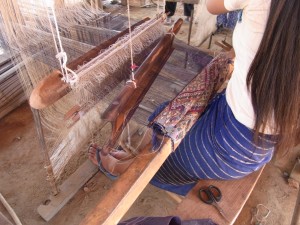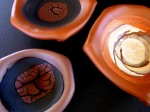Clayspace is an active ceramics co-op in Daylesford: you can find them on Facebook – https://www.facebook.com/ClayspaceDaylesfordRegionCeramicsCooperative.
On 9 August I was their invited speaker as part of the Words in Winter – http://wordsinwinter.com/event/- a wonderful annual event that links towns like Newstead, Daylesford, Castlemaine and others in our region.
Outside our meeting room, their midwinter wood firing in a Steve Harrison kiln slowly crept towards temperature, regularly stoked.
——–

Tonight I want to share some ideas about what inspires us to make? To pick up the clay, the paintbrush, the thread. And to make an object – to use, enjoy, or to share.
My making is based on clay, and a lot of my inspiration is based on the land or place. So I’ll talk a bit about the idea of place, our connections to place and some of the ways that I have sought to express my feelings of connection or sometimes disconnection to place.
And of course clay and place or land are very connected!
I grew up in Murrumbeena – a suburb between Caulfield and Oakleigh. Over my back fence was the abandoned outer circle railway line – it was the country – paddocks, horses, big eucalypts, long grass and a flooding creek. It was an extraordinary place – a wild place – one of those kinds of places that suburban has now vanquished. And I know that my wild place in now a neat and mown park.
It’s only since starting to live in the country – at Green Gully near Newstead – and reflecting on the joys that living there has for me that I have realised how influential growing up with a wild space to play has been for me.
What is place?
Both my ceramics and my other work as a heritage consultant relate to place. What is place? Some words that connect to place for me – land, country, place, space, landscape, earth, here, home, water, sky, dwell. Especially country – country that lives, breathes, is present.
Tuan (1974) defined place as space with meanings – meanings imbued through lived experience and Barbara Bender (1993) said ‘The landscape is never inert: people engage with it, re-work it, appropriate it and contest it. This is part of the way in which identities are created and disputed …’
I would like to look at three places and how I have engaged with them and created ceramic work in response: central Australia, central Victoria, and Laos.
Alice Springs
I studied ceramics at ANU as part of the distance diploma. This followed classes with Jane Sawyer and then part of a Dip Art at Homesglen TAFE.
In the ANU course, the last part-time year is an Independent Work Project – I started with the idea and the word “Imprinted” – that is that the land imprints into us. I spent 6 weeks in Alice Springs as part of my IWP – working in the Central Craft studios – making pots. When I applied for a ‘student residency’ there I said I wanted to:
…explore ideas related to the landscape of Alice Springs, especially the immediately landscape of the ranges and sand country.
… use the time there to look at landscape form and meaning, and to develop some ideas about layering – both in terms of the complex meanings (imprints) on the landscape and in the creation of layered ceramic surfaces.
… to refine my ideas, develop specific concepts and build a vocabulary of surfaces and techniques through an intensive focus on my ceramics work for this period
Being in Alice and Central Australia was interesting – and I was looking to respond to places that are not mine in any sense – so it was about a process of coming into relationship with a place – the processes of experience, learning, witnessing, feeling, sensation.
I was interested in the profound experience of being in a place – the power of place – emotional response to place – and how this entwines itself with what we know, what we fear, what we crave. and on the other hand I am interested in landscape – the opposite to the experienced place – landscape as the seen place – from the viewing point. In the idea of landscape – we are not of the land – we are outside – we are observers.
My ceramics are set with a body of ideas that I am interested in – and these are part of my other life as a heritage consultant and historian. So this is my context – less a context of material culture than it is of ideas.
While in Alice I did a trip out to some communities – to Yuendemu, to Haasts Bluff (Ikuntji), to Hermansberg – and to Gosses Bluff/Tnorala – a place I had seen before from a distance but this time never been inside. Actually being there and learning the story was powerful.
I also ran the ceramics studio – cleaning it up, recycling clay, firing the kilns, running a workshop, testing what was in the mysterious glaze buckets etc!
Earth and colour was my immediate focus: I started mixing clays and firing to different temperatures looking for a colour palette. I fired local materials at different temperatures – to see what happens when you subject different earths to another extreme. I played with slips and stencils – and I starting trying terra sigillata for the first time. I played with forms. And I wrote my first blog!
After returning from Alice I developed two bodies of work: Falling to Earth and Gorges and Gaps.
Gosses Bluff – Tnorula – was created by a ‘celestial body’. Western science says it was a comet – a frozen ball of gases whereas Western Arrente says a baby, falling in its coolamon fell from a dancing ground in the Milky Way. Both disappeared on impact.
 The Falling to Earth work I made seeks to convey both the act of falling and the sense of the land that the baby in its coolamon crashes into. The act of falling is ever-present – it is happening now. And so it is witnessed – it is part of today – not just part of the past.
The Falling to Earth work I made seeks to convey both the act of falling and the sense of the land that the baby in its coolamon crashes into. The act of falling is ever-present – it is happening now. And so it is witnessed – it is part of today – not just part of the past.
The second group of work – Gorges and Gaps – is laid out as land, to be walked through by the viewer. To imagine that journey that so many of us take looking at each gorge in the MacDonnell Ranges – these gorges are dark and mysterious – a pool of icy water at the foot of vertical cliffs. They seem to exude a presence – but so much is hidden.
The surfaces on both these series are also terra sigilatta, in layers. And these pieces – all of them have been held – cradled – polished. For me that directness of touch is important.
I’ll continue this story in my next posting.































